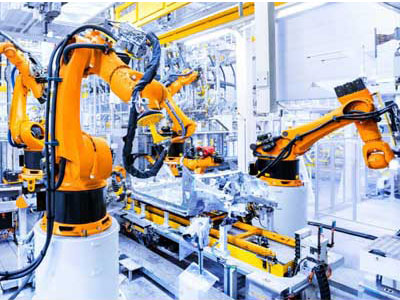Key Takeaway
Robots in industry are used primarily for three main tasks: material handling, processing operations, and assembly and inspection. In material handling, robots transfer materials and load or unload machines. For processing operations, robots handle tasks like welding, painting, and cutting. In assembly and inspection, robots assemble parts and perform quality checks. These robotic applications improve efficiency, accuracy, and safety in manufacturing environments, making operations faster and more reliable.
Automation of Repetitive Tasks
Automating repetitive tasks is crucial for efficiency and productivity in any industrial setup. At IndMALL Automation, we prioritize automation solutions to streamline operations. From automated data entry to process monitoring and control, our systems reduce manual labor, minimize errors, and enhance overall output. By integrating advanced technologies like PLCs and SCADA systems, we ensure seamless automation tailored to specific industrial needs. Trust us to optimize your workflow with reliable automation solutions that boost efficiency and profitability.

Precision in Manufacturing
In the realm of modern manufacturing, the integration of robotic systems represents a monumental leap forward in achieving unparalleled precision. Imagine a scenario where robots, equipped with cutting-edge sensors and meticulously programmed algorithms, execute tasks with microscopic accuracy that surpasses human capability. This precision is not merely impressive but essential, particularly in industries where even the slightest deviation can lead to significant repercussions.
Take, for instance, the intricate operations involved in circuit board assembly or the delicate welding required in automotive manufacturing. These tasks demand a level of precision that only advanced robotic systems can reliably deliver. By eliminating human error and consistently performing within micron-level tolerances, robots ensure that each component is assembled flawlessly and each weld is structurally sound.
For newly joined engineers entering the industry, understanding the role of robotics in achieving such precision is crucial. It’s not just about automation; it’s about mastering the art of integrating technology to enhance manufacturing processes. Robots not only streamline operations but also elevate quality standards, contributing to safer, more efficient production environments.
Enhanced Safety
In today’s industrial landscape, safety is paramount, and the integration of robots marks a significant advancement in ensuring workplace security. These machines excel in handling tasks that pose risks to human workers, such as dealing with hazardous chemicals, enduring extreme temperatures, or navigating confined spaces. By taking on these responsibilities, robots effectively reduce the occurrence of workplace accidents, allowing human workers to concentrate on more strategic and less perilous activities.
Imagine a scenario where a newly joined engineer is introduced to the concept of robotic safety in industrial environments. Picture an experienced industrial expert explaining how robots are deployed precisely to handle dangerous tasks, thereby safeguarding human personnel from potential harm. This expert would emphasize the critical role robots play in enhancing workplace safety standards, ensuring compliance with regulations, and minimizing the inherent risks associated with high-risk industrial operations.
Through clear, concise explanations, the engineer would grasp the transformative impact of robotics on industrial safety practices. They would learn that robots are not just machines but indispensable allies in maintaining a secure work environment. This knowledge empowers engineers to innovate with confidence, knowing that safety remains a top priority in every industrial endeavor.
Quality Control
In the realm of manufacturing, maintaining consistent product quality stands as an absolute priority. This ensures that every product leaving the production line meets rigorous standards and satisfies customer expectations. To achieve this, modern technologies, particularly robots equipped with advanced sensors and imaging systems, play a pivotal role.
These robots are not just automated machines; they are sophisticated tools capable of conducting meticulous quality control inspections. Using their precision sensors and high-resolution cameras, they detect even the slightest imperfections in products. This capability is unmatched by human inspectors, as it ensures that defects are identified with unparalleled accuracy.
By integrating robots into quality control processes, manufacturers can significantly enhance efficiency and reliability. These automated systems operate around the clock, consistently monitoring product quality without fatigue or oversight. This reliability translates into fewer defects reaching the market, thereby reducing rework and enhancing overall customer satisfaction.
Understanding the role of robots in quality control is crucial. It showcases how technology not only improves production processes but also sets new benchmarks for product excellence. As manufacturing continues to evolve, embracing these advancements ensures that Indian industries remain competitive on a global scale.
Efficiency and Productivity
In the realm of industrial operations, robotic automation stands as a pivotal advancement, revolutionizing workflows and boosting overall efficiency to unprecedented levels. Imagine a scenario where manufacturing processes are streamlined to minimize cycle times, enabling companies to achieve significantly higher production outputs within the same operational timeframe. This optimization not only translates into tangible cost savings but also enhances the competitive edge of businesses in the global market landscape.
Robots are not mere machines but strategic assets that orchestrate precision in every movement, from assembly lines to complex logistical operations. They ensure that tasks are executed with unwavering accuracy, minimizing errors that could otherwise lead to costly delays. For manufacturers, this reliability is a game-changer, allowing them to meet stringent deadlines and surpass customer expectations with prompt deliveries.
Moreover, the integration of robotic automation fosters a culture of continuous improvement within industrial settings. Engineers entering the field witness firsthand how these technologies redefine operational standards, paving the way for innovation and scalability. By embracing automation, businesses not only elevate their operational efficiency but also cultivate a workforce skilled in leveraging cutting-edge technologies for sustained growth and industry leadership.
Conclusion
Industrial robots enhance production efficiency by automating repetitive tasks, ensuring precision and consistency in manufacturing processes. Their flexibility allows adaptation to diverse production needs, from assembly to packaging, reducing operational costs and enhancing product quality. Integration of robots optimizes workspace utilization and improves worker safety by handling hazardous tasks. Enhanced productivity and quality assurance contribute to competitive advantages in the industrial sector, making industrial robots indispensable for modern manufacturing environments.
